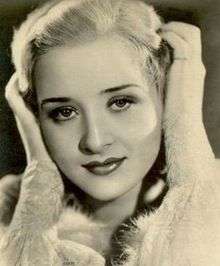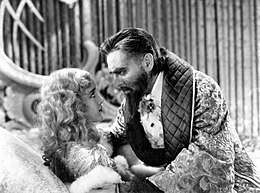Marian Marsh
| Marian Marsh | |
|---|---|
 | |
| Born |
Violet Ethelred Krauth October 17, 1913 Trinidad and Tobago |
| Died |
November 9, 2006 (aged 93) Palm Desert, California, U.S. |
| Resting place | Desert Memorial Park, Cathedral City, California[1] |
| Other names |
Marilyn Morgan Marian Henderson |
| Occupation | Actress |
| Years active | 1929–1958 |
| Spouse(s) |
Albert P. Scott (m. 1938; div. 1959) |
| Children | 2 |
| Relatives | Jean Fenwick (sister) |
Violet Ethelred Krauth (October 17, 1913 – November 9, 2006), better known by the stage name Marian Marsh, was a Trinidad-born American film actress and later an environmentalist.[2]
Early life
Violet Ethelred Krauth was born on October 17, 1913 in Trinidad, British West Indies (now Trinidad and Tobago),[3] the youngest of four children of a German chocolate manufacturer[4] and his French-English wife.
Due to World War I, Marsh's father moved his family to Boston, Massachusetts. By the time she was 10, the family had relocated to Hollywood, California. Her older sister, an actress who went by the name of Jean Fenwick, landed a job as a contract player with FBO Studios.[5] Another sister, Harriet, was a chorus girl who danced in Earl Carroll's Vanities. She changed her name to Jeanne Morgan.[6]
Marsh attended Le Conte Junior High School and Hollywood High School. In 1928 she was approached by silent screen actress Nance O'Neil who offered her speech and movement lessons, and with her sister Jean's help, she soon entered the movies. She secured a contract with Pathé where she was featured in many short subjects under the name Marilyn Morgan.
She was seen in a small role in Howard Hughes's classic Hell's Angels (1930) and Eddie Cantor's lavish Technicolor musical Whoopee! (1930).[4] The part in Whoopee! resulted from Marsh's visit to a film studio with her sister.[7] Not long afterwards, she was signed by Warner Bros. and her name was changed to Marian Marsh.
In 1930, at age 17, Marsh had the female lead in Young Sinners, a play at the Belasco Theater. A contemporary news article reported that she "has scored a distinct hit" in her first stage production.[8]
Hollywood success

In 1931, after appearing in a number of short films, Marsh landed one of her most important roles in Svengali opposite John Barrymore. Marsh was chosen by Barrymore, himself, for the role of Trilby.[3] Barrymore, who had selected her partly because she resembled his wife, coached her performance throughout the picture's filming. Svengali was based on the 1894 novel Trilby written by George du Maurier. A popular play, likewise entitled Trilby, followed in 1895.
In the film version, Marsh plays the artist's model Trilby, who is transformed into a great opera star by the sinister hypnotist, Svengali. The word "Svengali'" has entered the English language, defining a person who, with sometimes evil intent, tries to persuade another to do what he desires.
Marsh was awarded the title of WAMPAS Baby Stars in August 1931 even before her second movie with Warner Brothers was released. With her ability to project warmth, sincerity and inner strength on the screen along with critical praise and the audience's approval of Svengali, she continued to star in a string of successful films for Warner Bros. including Five Star Final (1931) with Edward G. Robinson, The Mad Genius (1931) with Barrymore, The Road to Singapore (1931) with William Powell, The Sport Parade (1932) with Joel McCrea Beauty and the Boss (1932) with Warren William, and Under 18 (again with William).
In 1932, in the midst of a grueling work schedule, Marsh left Warner Bros. and took several film offers in Europe which lasted until 1934. She enjoyed working in England and Germany, as well as vacationing several times in Paris. Back in the United States, she appeared as the heroine, Elnora, in a popular adaptation of the perennial favorite A Girl of the Limberlost (1934).
In 1935, Marsh signed a two-year pact with Columbia Pictures. During this time, she starred in such films as Josef von Sternberg's classic Crime and Punishment (1935) with Peter Lorre, The Black Room (1935) regarded as one of Boris Karloff's best horror films of the decade, and The Man Who Lived Twice (1936) with Ralph Bellamy.
When her contract expired in 1936, Marsh once again freelanced; appearing steadily in movies for RKO Radio Pictures where she made Saturday's Heroes with Van Heflin, and for Paramount Pictures where she played a young woman caught up in a mystery in The Great Gambini (1937). She appeared with comic Joe E. Brown in When's Your Birthday? (1937), and Richard Arlen in Missing Daughters (1939). In the 1940s, Marsh played the wife in Gentleman from Dixie (1941) and, in her last screen appearance, Marsh portrayed the daughter in House of Errors (1942) which starred veteran silent film actor, Harry Langdon.
In the late 1950s, she appeared with John Forsythe in an episode of his TV series Bachelor Father and in an episode of the TV series Schlitz Playhouse of Stars before retiring in 1959.
Personal life
Marsh married a stockbroker named Albert Scott on March 29, 1938 and had two children with him. They divorced in 1959. In 1960, Marsh married Cliff Henderson, an aviation pioneer and entrepreneur whom she had met in the early 1930s. They moved to Palm Desert, California, a town Henderson founded in the 1940s.
In the 1960s Marsh founded Desert Beautiful, a non-profit, all-volunteer conservation organization to promote environmental and beautification programs.[9]
Cliff Henderson died in 1984 and Marsh remained in Palm Desert until her death.
Death
On November 9, 2006, Marsh died of respiratory arrest while sleeping at her home in Palm Desert. She was 93. She is buried at Desert Memorial Park in Cathedral City, California.[10]
Legacy
- October 17, 2015 was designated as Marian Marsh-Henderson Day by the city of Palm Desert, California.
Complete filmography
- The Sophomore (1929) (uncredited)
- Don't Believe It (1930 short)
- Hell's Angels (1930) as Girl Selling Kisses
- Whoopee! (1930) as Harriett Underwood (uncredited)
- The Naughty Flirt (1931) as Kay's Friend (uncredited)
- Svengali (1931) as Trilby O'Farrell
- Under Eighteen (1931) as Margie Evans
- Five Star Final (1931) as Jenny Townsend
- The Road to Singapore (1931) as Rene March
- The Mad Genius (1931) as Nana Carlova
- Under Eighteen (1931) as Margie Evans
- Alias the Doctor (1932) as Lotti Brenner
- Beauty and the Boss (1932) as Susie Sachs
- Strange Justice (1932) as Rose
- The Sport Parade (1932) as Irene Stewart
- The Eleventh Commandment (1933) as Corinne Ross
- Daring Daughters (1933) as Terry Cummings
- Notorious But Nice (1933) as Jenny Jones
- A Man of Sentiment (1933) as Julia Wilkens
- Love at Second Sight (1934) as Juliet
- I Like It That Way (1934) as Joan Anderson
- Over the Garden Wall (1934) as Mary
- Der verlorene Sohn (The Prodigal Son) (1934) as Miss Lillian Comstock
- A Girl of the Limberlost (1934) as Elnora Comstock
- In Spite of Danger (1935) as Sally Sullivan
- Unknown Woman (1935) as Helen Griffith
- The Black Room (1935) as Thea Hassel
- Crime and Punishment (1935) as Sonya
- Lady of Secrets (1936) as Joan
- Counterfeit (1936) as Verna Maxwell
- The Man Who Lived Twice (1936) as Janet Haydon
- Come Closer, Folks (1936) as Peggy Woods
- When's Your Birthday? (1937) as Jerry Grant
- The Great Gambini (1937) as Ann Randall
- Youth on Parole (1937) as "Bobbie" Blake
- Saturday's Heroes (1937) as Frances Thomas
- Prison Nurse (1938) as Judy
- A Desperate Adventure (1938) as Ann Carrington
- Missing Daughters (1939) as Josie Lamonte
- Fugitive from a Prison Camp (1940) as Ann Baldwin
- Murder by Invitation (1941) as Nora O'Brien
- Gentlemen from Dixie (1941) as Margaret Terrill
- House of Errors (1942) as Florence Randall
References
- ↑ Marian Marsh at Find a Grave
- ↑ bio on Marian Marsh; by Hans J. Wollstein
- 1 2 Lentz, Harris M., III (2007). Obituaries in the Performing Arts, 2006: Film, Television, Radio, Theatre, Dance, Music, Cartoons and Pop Culture. McFarland. pp. 228–229. ISBN 9780786429332. Retrieved 26 July 2018.
- 1 2 Bernstein, Adam (November 14, 2006). "'30s movie heroine Marian Marsh; starred with Barrymore, Karloff". Arizona Republic. Arizona, Phoenix. Washington Post. p. 27. Retrieved July 25, 2018 – via Newspapers.com.

- ↑ "Marian Marsh: Biography". IMDb. Retrieved 2015-03-03.
- ↑ Donati, William (2011). The Life and Death of Thelma Todd. McFarland. p. 18. ISBN 9780786488179. Retrieved 8 October 2017.
- ↑ "Sister of Actress Wins Film Chance". The Los Angeles Times. California, Los Angeles. May 3, 1930. p. 18. Retrieved July 25, 2018 – via Newspapers.com.

- ↑ "Marian Marsh Scores Hit in Belasco Play". The Los Angeles Times. California, Los Angeles. October 24, 1930. p. 29. Retrieved July 25, 2018 – via Newspapers.com.

- ↑ Marsh, Marian. "Marian Marsh – Forever Trilby, Biography of the 1930s Screen Beauty". immortalemphemera. Retrieved 2015-03-03.
- ↑ Wilson, Scott (2016). Resting Places: The Burial Sites of More Than 14,000 Famous Persons, 3d ed. McFarland. pp. 479–480. ISBN 9781476625997. Retrieved 26 July 2018.
External links
- Marian Marsh on IMDb
- Marian Marsh at AllMovie
- Marian Marsh at Virtual History